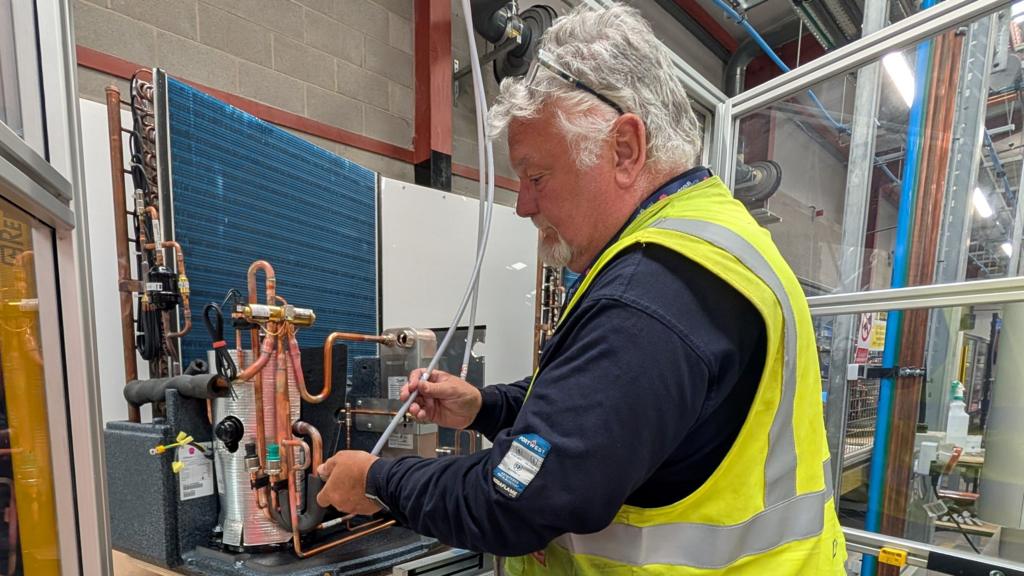During my visit to Octopus Energy’s heat pump factory in Craigavon, Northern Ireland, London experienced temperatures reaching 29C.
Several staff members, typically stationed in the south of England, expressed their delight at escaping the heat.
Their sentiments are understandable, as climate change contributes to rising temperatures in the UK. Consequently, decarbonizing energy systems, including domestic heating, becomes increasingly crucial.
Octopus Energy is manufacturing its own heat pump designs, which run on electricity rather than fossil fuels, at this facility in Northern Ireland.
“It kind of gets harder as you go up – it’s like levels in a game,” remarks Patrick Doran, a factory employee, after a tour of the production line.
He explains that within a year, he has completed training in each phase of the manufacturing process.
Doran enthusiastically describes his work, which ranges from fitting pipework to connecting internal electronics with cable bundles. “I get to do something different every day,” he says.
The government aims to have 600,000 heat pumps installed in UK homes annually by 2028, a target just three years away.
While installation rates have recently increased, the nation still lags considerably behind this goal. Total UK heat pump sales were just under 100,000 in 2024.
Demand for heat pumps surged in Europe following Russia’s invasion of Ukraine in 2022, as gas prices soared. However, that initial enthusiasm has since waned.
With gas prices stabilizing, heat pumps are encountering greater difficulty competing with gas boilers regarding running costs.
This factory, housed in a medium-sized warehouse, currently produces 600 heat pumps per month. Production is expected to double with the activation of a second line.
Octopus could potentially introduce additional shifts to significantly increase output if demand rises.
Aimee Clark, head of commercial, explains that Octopus aimed to manufacture its own heat pump to offer a “plug-and-play solution that works in the majority of homes in the UK,” a strategy that distinguishes it from most electricity providers.
Other manufacturers, such as Vaillant, also have UK manufacturing sites. Copeland, a heat pump component supplier, operates a factory in Northern Ireland, providing compressors to Octopus.
Heat pumps function by extracting heat from the surrounding environment, typically the air. This process effectively harvests free heat.
Ambient heat warms and expands a refrigerant inside the heat pump. A compressor then compresses the refrigerant, further increasing its temperature.
Finally, a heat exchanger transfers the heat to water, which is then circulated through radiators.
Octopus heat pumps feature a unique design, encased in dark grey plastic. While the aesthetics might be considered understated, the design incorporates original technology.
Mateusz Dewhurst, director of manufacturing, highlights a patented internal metal plate through which refrigerant flows. This plate absorbs heat from the machine’s electronics, cooling them down and providing “a performance gain,” according to Dewhurst.
The heat pump’s casing contains small grey insulation beads, similar to those used in cavity wall insulation, to minimize heat loss, he adds.
Heat pump technology has existed since the 19th century.
Zhiwei Ma of Durham University notes that manufacturing these devices is relatively straightforward, having built one himself during his PhD studies.
Dr. Ma states, “It worked fine,” adding that companies like Octopus can procure main components and assemble a finished product. He believes that “There’s very little room to improve anything.”
Octopus disagrees, asserting that its design choices enhance overall performance, which the company monitors using strategically placed heat and pressure sensors within the device.
Heat pumps can generate multiple kilowatts of heat for each kilowatt of electricity consumed, measured by their coefficient of performance (COP). Maximizing the COP is crucial for minimizing running costs.
Octopus technicians can intervene if sensor data indicates a significant performance decline. Customers also receive an overview of their heat pump’s efficiency through a smartphone app.
Steven Metcalf of the University of Warwick emphasizes the importance of competent heat pump installation. He and his colleagues collaborate with Mitsubishi, which operates a heat pump factory in Scotland.
Metcalf explains, “It could be the difference of a COP of 2.5 versus 4 – your bills will scale with that,” underscoring the “huge penalty for getting a bad install.”
Public acceptance hinges on confidence that switching to heat pumps won’t be a significant problem, especially considering that heat pumps have been widely adopted in colder countries like Norway.
Octopus reports that customer surveys indicate most find their heat pump costs the same or less than their previous gas boiler, providing equal or superior comfort.
Paul Kenny, director general of the European Heat Pump Association, suggests taxing fossil fuels more heavily to incentivize the adoption of electric alternatives for domestic appliances.
Kenny notes that “Right now what we have is factories that are at low capacity factors, they’re idle or running well below what they could be running,” reflecting the current slowdown in European heat pump demand.
Greater consistency in subsidy programs could also help.
Despite having the highest proportion of highly-polluting oil heating systems in the UK, Northern Ireland lacks a widely available grant to reduce the cost of heat pump installations, making it unique within the UK and Ireland.
After my factory tour, I pointed out the irony of manufacturing heat pumps here to TJ Root, Octopus’s Cosy program director. “It’s incredibly ironic,” he agreed.

